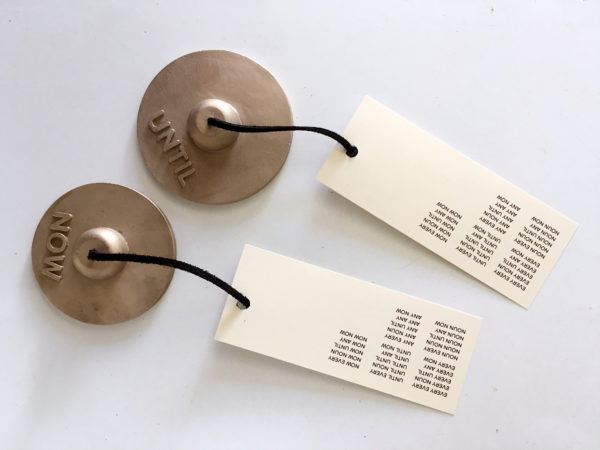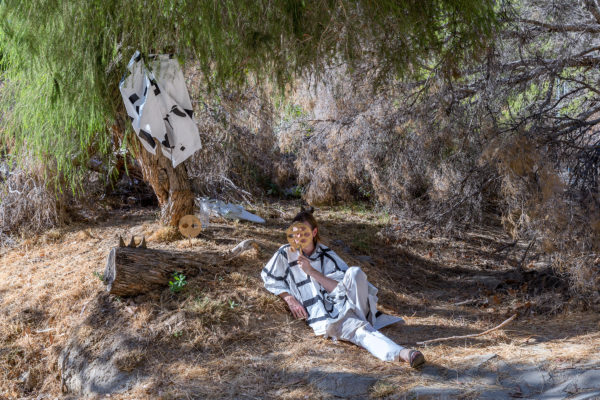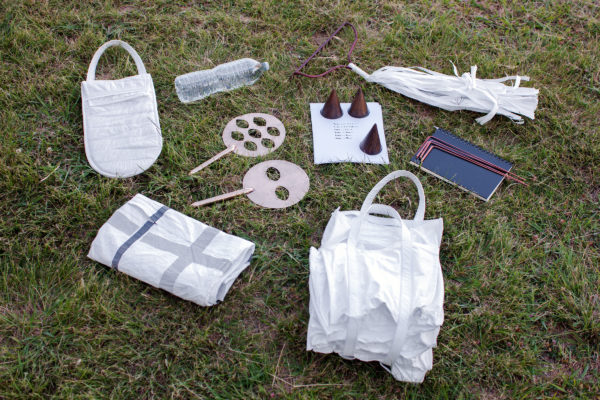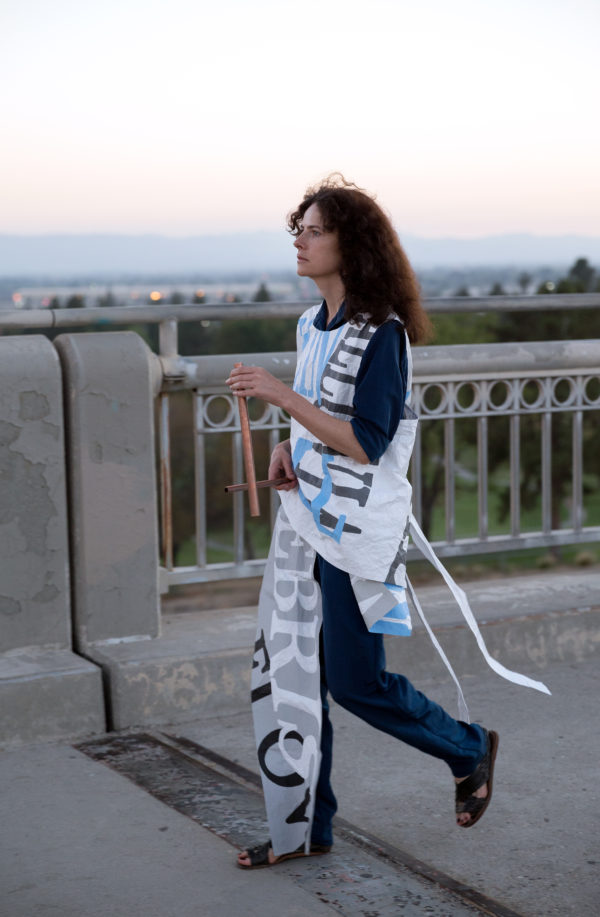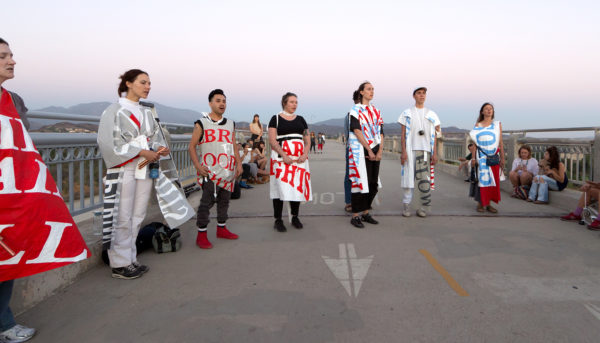EVERY NOUN UNTIL ANY NOW is a poem composed of five hundred bronze bells, each containing a single word. The poem is sounded out by more than one person, striking one bell against another. Each word has its own tone. There is no complete poem here, only possible combinations of words and tones and ways of striking one against another. The entire set of bells was handed out on the corner of 1st street and Grand Avenue in Los Angeles at midnight, to a mixture of audience exiting Walt Disney Concert Hall and those who happened to be passing by at the time. The shape of the piece is to ring and disperse. Commissioned by Los Angeles Philharmonic.
M.O.S.
M.O.S. means:
motor only shot
mit out sprechen
mit out sound
missing optical sound
most obvious solution
motion on screen
movement opposite sound
multiple occurence schema
myth of sequence
mental open screen
my oscillating story
may otherwise suggest
mind outlines speech
meaning or sign
might over-simplify
memory output system
matter of sync
mockup of situation
mirrors original sample
M.O.S.

All night, we record sounds at the open air cinema. The recordings are compressed and expanded (not quite the right way) with the spectrum blurred, a harmonic echo. All the next day we play the blurred sounds back into the open air cinema (an example below). The title “M.O.S.” is taken from a term (with no certain origin) used to indicate an image filmed without synchronous audio track.
Presented as part of the Hallucinations program organized by filmmaker Ben Russell as part of Documenta 14 in Athens, Greece..
agreements video
Agreements 5-10 description
“Agreements (5—10)” consists of two objects (cast steel tuning forks) and six radio transmissions. Two of the radio transmissions originated with antennas in the courtyard of Ballroom Marfa, the other four were distributed at various locations around Marfa, TX, forming a ring around the town so that you were never more than 1000 feet or so from a transmitter. The transmissions, overlapping geographically and all broadcasting on the same frequency (106.1 fm), compete with one another to reach the listener who chooses to tune in. This competing interference manifests as pockets of clarity, separated by boundaries of noise and silence. Listening while moving, one can hear these borders as they are crossed, and the shift between territories can be heard as dominance rotating from one signal to another.
The tuning forks, one double-sided and the other four-sided, resonate with two and four narrowly-separated pitches, respectively. Each of these reference pitches corresponds directly to one of the six radio transmissions introduced into the otherwise quiet radio spectrum, serving as the basis for the musical universe contained in that signal. All sounds heard in a transmission conform to the tuning note, and its attendant harmonics, that belongs to that transmitter.
Cast as single objects that hold multiple reference pitches, the forks present the limits of sensing the whole of a group. Listening to each individual part in turn, you hold the sound of one ringing note in your memory in order to compare it to another sound. Similarly, your sense of each radio signal is interrupted as your position changes, and the relative power of all signals shift. This is not just a problem of simultaneity, or of a fixed point of view; this is a model of difference—a multiplicity of centers—that is based on inter-penetration, dominance and exclusion, rather than the wave-like interference of phases.
Holding one of the tuning forks in your hand, striking it or tapping it to let it ring, it is clear that each vibrating side produces a complex sympathetic resonance in each of the other sides. Holding any of the sides to mute vibrations, it is possible to alternate between a striated, harmonic sound and a smooth, pure tone. Repetition, with difference. Each transmission carries its own information. What you hear tells you where you are—variations on a theme: wild variations that conform to a system. This is, unfortunately, not the system of infinite combinations imagined when considering sound as a social material, interconnecting listeners universally and without friction, layering and blending to synthesize new forms from multiple masters. This is, luckily, the coequal and simultaneous possibility of multiple, separated centers that can interact but don’t. You can move from one place to another, or you can stay still, friction is the constant force.
∆ (Delta)
“∆” (“Delta”) is the title character of a site-specific performance that took place over the course of a month in Bee Canyon Park, in the Granada Hills section of Los Angeles—across the street from the Metropolitan Water District’s largest drinking water treatment plant, and nearby to the super-leaky Aliso Canyon methane storage facility. Every day from 4—6pm, a new performer or group of performers assumed the ∆ persona anonymously.
Like a pool of water being treated—flowing in, changing state, flowing out—∆ signifies difference, a changing state, dislocation, in process and in dispute. ∆ is a mercurial messenger, a conduit, and a portal existing in multiple locations at once—present, accessible and responsive to both local and remote sites (∆ could also be Delta, Utah; home to the Intermountain Power Project, which burns coal to make electricity for Los Angeles, 500 miles away). Embodying the remote “grounding” of LA’s water and power infrastructure across vast distances, ∆ is of the landscape, a bit of sediment washed down from the San Joaquin River Delta, not a guide, but a transplant from the source.
Delta’s Toolkit
Text-based scores inside ∆’s toolkit are composed using a specially-designed typeface. A geometric font with ornaments, the typeface mixes handmade and computer-generated shapes and curves and is not completely readable by either machines or humans.
delta
Each performer or set of performers assuming the role of ∆ made use of a “toolkit” that lived on-site—a specially-designed container made to hold scores, objects, and materials for use in daily tasks, interactions and meditations. Sculptural as well as functional within each performance, objects in the toolkit served alternately as props, costumes, and staging materials (a banner becomes a garment, becomes a blanket, becomes a shelter, for example); tools for documentation, communication, sound-making, writing, and analysis; and elements in choreographed exchanges, dances, and musical gestures.
Every day ∆ opened the toolkit to find instructions and resources for performance and engagement with visitors—ceremonial exchanges, as well as actions staged for video, photographer, or sound recorder—remote cartography (tracing boundaries and topographies), and processes of filtering, purifying, processing, and transmitting. At the end of each day, ∆ returned the contents to the toolkit where they are stored until the next day.
The Spreading Ground
The Spreading Ground (2016) was a month-long series of open rehearsals and performances at Hansen Dam, regularly scheduled practice for moving through Los Angeles as a site of transformative power and environmental hazard, commissioned by the Los Angeles Department of Cultural Affairs. This performance practice sought to connect ideals of natural beauty with precarity, and the infrastructure that holds this balance in place at inhuman, yet profoundly accessible, scales. The open rehearsal process resulted in the composition of a simple text score for movement and voice, a libretto that was painted across costumes like banners, and a collection of electronic sounds composed for a large group of bluetooth speakers. The Spreading Ground culminated in a dramatic walking meditation by a chorus of fifty performers, each performing a discrete part of the score, spread along the two-mile length of Hansen Dam with audience interspersed and constantly moving alongside.
The Spreading Ground – video
The Spreading Ground
Libretto:
A:
1.
warm air meets cold dove
rushing down denuded slopes
2.
cloud burst over higher
elevation inland moving
3.
cloud saving for summit
gullies feed canyons
4.
Los Angeles River east
San Gabriel River west
5.
stay between levees
city of a thousand rivers
6.
deposit silt
soak below
flow to sea
7.
fertile beds alluvial
sediment plain lush
8.
hydraulic order
unruly river
smooth out uneven
9.
uncertain rainfall
un-flowing as planned
10.
steep slopes
small ranges
plain to pinnacle
11.
tectonic moves
rise like himalayas
12.
clay so soft
forms to hands
13.
chapparal blazes
flames regenerate
14.
foothill flip bucket
predict the slide
15.
flood flow
channel volume
levee strength
16.
forbidden territory
freeway overpasses
17.
return sycamore
return oak
return cottonwood
18.
riparian civil disobedience
mental maps of southern california
19.
no signs of life
sun high in the sky
20.
raindrops vary
places rain does not reach
21.
rage with flood
dry in the sun
22.
oranges, acorns, currants
blackberries, gillyflower, jessamine, tuberose
23.
water privilege
riparian rights
24.
mountains riding clouds
mountains walking on water
25.
mountains walking like humans
forward backward on water
26.
no original water
no common water
27.
water commons
superstructure
matrix of water
28.
underground river
subterranean streams
flowing in channels
29.
beneath the river bed
underground water
30.
ditch drag thicket
channel concrete
31.
downslope impermeable
layer gathering
32.
hillside saturate glob
too dry to flow
33.
detritus cones
inundation zone
34.
concrete articulation
river future
35.
improve water quality
enhance riparian
36.
industrial whiff ripping
stately heron
37.
water trickle
earthen low-flow
38.
persuade the public
the river exists
39.
brutal trip
pioneer drag
western settlement
40.
abundance of water
from elsewhere
not here
41.
chalky river relocated
snake of water
42.
artesian well driller
ditch tender
43.
save your head from water
save your head from fire
44.
water underground
spreading ground
45.
rainfall to fill
sandy bed
capricious cloud
B (shared):
Flood Control
Spill Away
Flows Within Boundaries
Spreading Ground
C (shared):
cloud
flow
away
soak
freeway
—–
flood
worlds
water
you
17000 observations
“17,000 Observations” (2014) is a musical composition and sculptural installation developed specifically for the floodplain forest at Laguna Gloria, in Austin Texas. A mobile made up of circular mirrors is suspended between trees across a footpath, reflecting the forest in unpredictable ways, aiding and complicating each viewer’s line of sight. Field recordings made on-site over a 24-hour period form the basis of the musical composition: the songs and calls of migratory birds overlap, modulate, and give way to one another in sequence. Each audience member determines their own path through the performance, following the forest’s natural trails to collect fragments of call-and-response from an instrumental ensemble dispersed throughout the floodplain. “17,000 Observations” is an attempt to respond to—and reinforce—the sequences and transitions that accumulate to define a natural site, from all around, with no center.
17000 observations – video documentation
The Anti-Explainers
“The Anti-Explainers” (2012-2015) is a collection of experiments and interventions performed while in residence at the Exploratorium’s Center for Art and Inquiry in San Francisco, including the public artwork “DAYLAY” (2013-2014), an interactive audio installation on The Embarcadero that captured sounds to be played back after a twelve-hour delay.
The Anti-Explainers
Microphones inside of a hole in the pier perpetually capture sounds, playing them back through on-site speakers after a twelve-hour interval. Nothing is recorded, only delayed. An environment is shifted. An invitation to leave a message for the future: night speaks to day, day speaks to night.
All sounds were subject to the same delay, without discrimination: seagulls, trolley cars, skateboarders, church bells, school groups, office workers, tourists, families, lovers, foghorns, delivery trucks, queries, fantasies, confessions, wind, rain, screaming children; the audibly prurient thoughts that occupy people of all ages speaking into the void. Our intent was to produce two irreconcileable results: on the one hand, to render a realistic portrait of the natural and social sounds of one time overlaid onto another time (a sort of factual window for listening through to a different time at the same location), and on the other hand, to invite visitors to contemplate and engage with their own imaginary experience of this other time—to actively touch the other (as yet non-existent) time. Our project here is to examine the feedback loop produced by these twin results, not by categorizing, but by presenting their complexity verbatim.
Is the relevant learning experience to be found in focused attention on sound (both as a material and a signifying medium)? Is the exhibit’s primary purpose to play back / to present for the listener, or to offer, in the process of time-shifting, a platform for experimental performance? We propose that a relevant learning experience can be found in the creation, by speakers and listeners alike, of a common imaginary, a virtual space for contemplation external to our lived experience. I wonder where my voice went (what does it do for twelve hours?). I consider the qualities of a moment lost inside a vast duration. I switch places with the listener, bringing a message backwards from the future into the past. Why not?
Taken as a continuous document, the recorded messages present a rapid and unpredictable montage of emotional forms. Some speakers invoke complex and playful narratives consisting of interactions between multiple characters, story-lines, and time-space locations. Other speakers laugh or curse when nothing is obviously funny or upsetting, leaving an embarrassed phantom shocked at its own creepiness; uncanny for being a recording, and irresponsible for being delayed.
Why speak, if the audience can’t be verified? Paranoia interrupts, the un-knowable listener is cast as “inhuman,” albeit an inhuman that we share space with and can communicate with: “Nobody” will be there / “Nobody” was here—or “Whoever is here, I hate you,” “I will kill you,” “I hope you die,” and so on. Often this takes gentler forms, as interspecies communication (whale song, “Sharks come out!”, “Hello, fishies!” etc.), or command utterances seeking a cure for disarray: “Go to work!”, “Go Home!”, “Get a job!”, “Go to sleep!”, “I hope to be at home safe.” For a group encountering the piece all at once, the mania of showing off, along with a tendency towards imitation, results in funny looping stutters, as variations on the roles of teacher, student, reporter, monster, victim, etc. are worked out.
How do we rationally understand a time scale or duration outside of what we are able to sense? Every interaction is also a test of the channel’s openness, a question uselessly waiting for an answer to travel across an interval that, while not impossible, is improbable for anyone finding themselves at the installation site to directly experience. Leaving a message as a ‘proof’ or ‘truth’ of a proposition that is un-testable (un-thinkable?) in the present moment engages a need very close to our own desire to collect and convey these messages, first through the mechanism itself, and now through these eavesdropped transcriptions. In the act of composing messages for future listeners, each speaker has given a unique form to the sensation of holding one’s attention in two times at once. As artists-in-residence transiently interacting with communities of practice, our research is presented beside the work of explanation and inquiry carried out by visitors and staff every day. In the usage described by Eve Kosofsky Sedgwick: “Beside comprises a wide range of desiring, identifying, representing, repelling, paralleling, differentiating, rivaling, leaning, twisting, mimicking, withdrawing, attracting, aggressing, warping, and other relations.” As artistic research, this project is not to essentialize, nor to act as role-model or interrogator, but primarily to listen, and to provide forms that are able to preserve contradiction.
